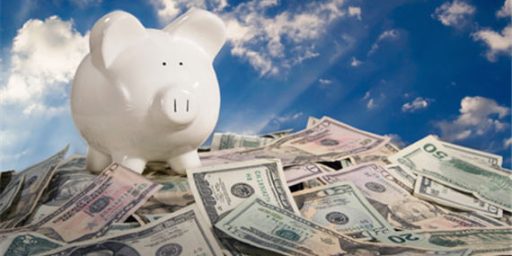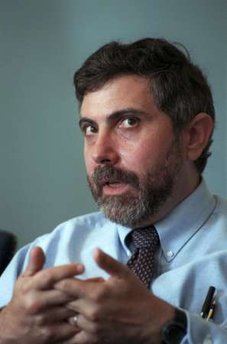Economic Cage Match: Mankiw vs. Krugman
President Obama’s claim to reduce the deficit to 3% of GDP by 2013 rests in part on a growth forecast where this year GDP will shrink only by 1.2% and will grow between now and 2013 by 15.6%. Prof. Mankiw noted that this might be overly optimistic in this post, and followed up with this post suggesting that the growth forecasts might be overly optimistic.
The issue here is rather technical. Is the U.S. economy, or more accurately GDP, a trend stationary process? That is, does the GDP move around a stationary trend where a temporary deviation downwards from the trend imply that there will be a similar movement in the opposite direction later on to return us to trend? Or is GDP better described by what is called the unit-root hypothesis. In this case, changes to the time series are permanent, not transitory. Of course, there is some controversy over the issue of a unit root for things like GDP.
This post by Prof. Mankiw sparked this response by Prof. Krugman titled “Roots of Evil (Wonkish)”.
I always thought the unit root thing involved a bit of deliberate obtuseness — it involved pretending that you didn’t know the difference between, say, low GDP growth due to a productivity slowdown like the one that happened from 1973 to 1995, on one side, and low GDP growth due to a severe recession. For one thing is very clear: variables that measure the use of resources, like unemployment or capacity utilization, do NOT have unit roots: when unemployment is high, it tends to fall. And together with Okun’s law, this says that yes, it is right to expect high growth in future if the economy is depressed now.
But to invoke the unit root thing to disparage growth forecasts now involves more than a bit of deliberate obtuseness. How can you fail to acknowledge that there’s huge slack capacity in the economy right now? And yes, we can expect fast growth if and when that capacity comes back into use.
This prompted this rejoinder from Prof. Mankiw asking Prof. Krugman to place a bet on whether or not the Obama Administration’s growth forecasts would obtain. So far Prof. Krugman has not taken the bet. I find it rather telling myself. After all, if Prof. Krugman is so sure that there is huge slack in capacity he is just leaving money sitting on the table.
I’d also add that Prof. Mankiw has pointed to other sources that also suggest that growth wont be as rosy as the Council of Economic Advisors is suggesting. For example, in the chart that Prof. Delong uses to support the CEA forecast the slope of the curve is largely determined by data points that correspond to the economic recovery during the Reagan years following the two recessions in the early 1980s. Remove those years from the sample and you get a much lower slope. It is still positive, but it is less steep. As Tom Maguire notes,
Let’s end with a chortle – isn’t it nice to see Krugman and DeLong relying on the Regan-era tax cut fueled boom to justify the Obama-era recovery plan?
Maguire also points us to this post by Arnold Kling. This is a very good post that is devoid of the rancor seen in Krugman’s post and the condescension in Brad DeLong’s post. Arnold explains the intuition of the unit-root hypothesis,
Think of trend-stationary as an economy where the movements in output are driven by transitory factors. Eventually, the economy returns to a path determined by steady growth in capacity.
Think of a unit-root economy as one in which movements in output are driven by permanent factors. The economy does not return to some pre-determined path. Instead, starting from wherever you are, you grow at some average rate.
In terms of the current situation, suppose that the economy is down because people are postponing the purchases of cars and other goods out of fear. That would be a trend-stationary story, because it suggests a nice rebound when people get over their fear. On the other hand, suppose that the economy is down because we accumulated the wrong types of physical capital (houses) and human capital (skills in mortgage securitization). That is a unit-root type problem. Yes, the economy will start growing again at some point, but that misallocation of physical and human capital is a permanent loss. We are not going to make up for it with some above-normal growth.
And to muddy the waters even more, both could be right. People are worried right now and are “battening down the hatches”—i.e. they are saving, eating at home, delaying large purchases, in short not spending. On the other hand we have a very large stock of housing that means a lot of resources are now locked into these buildings that people simply aren’t buying. And the financial sector is taking a huge hit and it is likely we have too much human capital in that area. I think that is Mankiw’s real point. That, sure, we’ll see positive growth in the future, but there is nothing that says it has to be above normal growth to return us to trend.
I would also point out that the past two recessions would, I think, favor Mankiw. Both recessions had long lag times in an unemployment rebound. In fact, for the last recession this prompted Krugman to refer to Bush as Herbert Hoover, the only president to finish his first term with a lower number in the payroll employment survey. The payroll survey peaked in early 2001 and the trough was in mid 2003. Was that lag in the turn around in the payroll survey due to structural changes in the economy? If yes, then that is what is behind unit-root results. So I think Mankiw is right to suggest that there is reason to think that growth might not be as robust as the CEA think, even though I hope DeLong and Krugman are right and we’ll see robust growth starting in 2010 and continuing through 2013.






To make a surface-level comment:
1) Presidents always choose rosy predictions, of those available.
2) Anyone who don’t want “talking down” the economy, you should buy into that.
(I believe Mankiw’s administration put out some rosy forecasts itself, and to the degree that they they were within general consensus, that was fair.)
It’s worth noting, on the “how confident are you” metric, that Krugman accepts comments, while Mankiw hasn’t for quite some time (after being, correctly in my opinion, often attacked for shill-like posts during the last administration).
I think this is even more true of people who don’t take bets where previously they had staked out a position of near absolute certainty.
I’m willing to bet that they are both wrong. If there is anything we have learned in the last year or so, it is that macroeconomists are very smart people whose ability to make useful predictions approaches zero.
So we are going to have….what? Zero growth? Negative growth till 2013? That is about all you’re left with. I’m more doubtful of those two outcomes than high to moderate growth.
Depends on the taxonomy of the recession. It sounds like the Obama Administration is counting on a V-shaped recession. I find that pretty unlikely, based on what we’ve seen so far. A U-shaped recession would be likely to exhibit lower growth over the period in question than the Obama Administration’s and, presumbly, Dr. Krugman’s estimates.
I suspect and, mind you, it’s no more than a suspicion that we’re in for an L-shaped recession with possible double dips. That would mean no to very slow growth starting sometime towards the end of this year and extending for the foreseeable future.
One of the pieces of evidence I’d submit is that IMO for real growth we’re going to need real investment and right now most seem to be holding on for dear life.
Dollars to donuts the Obama administration is not “counting” on their public predictions, any more than the Bush administration (should have done).
Given (Odo mounts hobby-horse) that this is decision-making in the face of uncertainty, there is justification for choosing a V-shaped recovery as your best, but at the same time, low-confidence prediction.
You bet on it, but you don’t go all-in. You choose a strategy that is not disastrous in a U or L shaped scenario.
Far too many confounding variables.